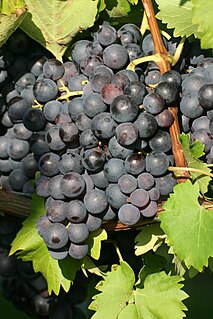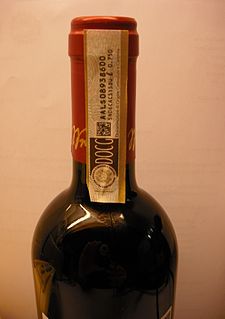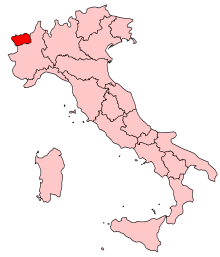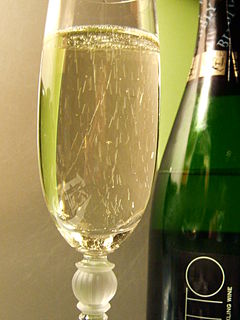Related Research Articles

Nebbiolo is an Italian red wine grape variety predominantly associated with its native Piedmont region, where it makes the Denominazione di Origine Controllata e Garantita (DOCG) wines of Barolo, Barbaresco, Roero, Gattinara, Carema and Ghemme. Nebbiolo is thought to derive its name from the Italian nebbia or Piedmontese nebia, meaning "fog". During harvest, which generally takes place late in October, a deep, intense fog sets into the Langhe region where many Nebbiolo vineyards are located. Alternative explanations refers to the fog-like glaucous veil that forms over the berries as they reach maturity, or that perhaps the name is derived instead from the Italian word nobile, meaning noble. Nebbiolo produces lightly-colored red wines which can be highly tannic in youth with scents of tar and roses. As they age, the wines take on a characteristic brick-orange hue at the rim of the glass and mature to reveal other aromas and flavors such as violets, tar, wild herbs, cherries, raspberries, truffles, tobacco, and prunes. Nebbiolo wines can require years of aging to balance the tannins with other characteristics.

Dolcetto is a black Italian wine grape variety widely grown in the Piedmont region of northwest Italy. The Italian word dolcetto means "little sweet one", but it is not certain that the name originally carried any reference to the grape’s sugar levels: it is possible that it derives from the name of the hills where the vine is cultivated. In any case the wines produced are nearly always dry. They can be tannic and fruity with moderate, or decidedly low, levels of acidity and are typically meant to be consumed within a few years after release.

Trollinger, Schiava, or Vernatsch, is a red German/Italian wine grape variety that was likely first originally cultivated in the wine regions of South Tyrol and Trentino, but today is almost exclusively cultivated on steep, sunny locations in the Württemberg wine region of Baden-Württemberg. It is primarily known under the synonyms Trollinger in Germany, Vernatsch in South Tyrol and Schiava in other Italian regions. As a table grape the variety is sometimes known as Black Hamburg, which is commonly confused with the similar synonym for Black Muscat—a variety that is actually a cross of Trollinger and Muscat of Alexandria.

Arvier ; is a town and comune in the Aosta Valley region of northwestern Italy.

Chambave is a town and comune in the Aosta Valley region of northwestern Italy.

Breganze is a town in the province of Vicenza, Veneto, Italy. It is northeast of Via Romea. During World War II, the Germans were on one side of the river and the Allies were on the other, and a firefight occurred across the river.
Pineau d'Aunis is a red French wine grape variety that is grown primarily in the Loire Valley around Anjou and Touraine.

Barbera d'Asti is an Italian red wine made from the Barbera grape. It is produced in the hilly areas of the provinces of Asti and Alexandria. Barbera d'Asti was accredited with DOC status in 1970, and DOCG status followed in 2008.

The Valle d'Aosta DOC is an Italian denominazione di origine controllata located in the Aosta Valley of northwest Italy. Surrounded by the Alps, the Valle d'Aosta is home to the highest elevated vineyards in all of Europe. The principal winemaking region of the Valle d'Aosta is found along the eastern banks of the Dora Baltea river with the city of Aosta serving as the central winemaking location. The region is divided into three main vineyard areas; the upper valley, Valdigne, the central valley and the lower valley,. To the south is the winemaking region of Piedmont. The Valle d'Aosta is Italy's smallest winemaking region both in terms of size and production with only about 330,000 cases produced annually in the region and only 36,000 cases produced under the DOC label. Seventy five percent of the area's production is red wine made mostly from the Pinot noir, Gamay and Petit Rouge varieties. A white wine is made from the indigenous Prié blanc grape by the cooperative of Blanc de Morgex et de La Salle.

Piemonte wine is the range of Italian wines made in the region of Piedmont in the northwestern corner of Italy. The best-known wines from the region include Barolo and Barbaresco. They are made from the Nebbiolo grape. These wines are ideal for storage and a well-aged Barolo for instance may leave a feeling of drinking velvet because the tannins are polished and integrated more and more into the wine. As the wine matures the colour becomes more brownish and rust-red.
Verduzzo is a white Italian wine grape grown predominantly in the Friuli-Venezia Giulia region of northeast Italy. It is also found in significant plantings in the Piave Denominazione di origine controllata (DOC) of the Veneto region, though some of these plantings may be of the separate Verduzzo Trevigiano variety. Verduzzo Friulano is used in varietal and blended wines, many of which fall under DOC as well as vino da tavola designations, that range in style from dry to late harvest wines. According to wine expert Oz Clarke, most of the sweeter examples of Verduzzo can be found in the Friuli-Venezia Giulia with the grape being used for progressively drier styles of the wine the further west into the Veneto.
Perricone is a red Italian wine grape variety that is grown in Sicily. In the late 20th century there was around 1000 hectares/2,500 acres of the grape planted throughout the island. According to wine expert Oz Clarke in Sicily Perricone is used to make full bodied, deeply colored, highly alcoholic wines.
Bombino nero is a red Italian wine grape variety that is grown in southern Italy, particularly the regions of Apulia, Basilicata, and Lazio, as well as on the island of Sardinia. It is a permitted grape variety in the Denominazione di origine controllata (DOC) wines of Castel del Monte and Lizzano. The grape is primarily a blending grape but it can also be used as a varietal for red and rosé wines. Though DNA evidence has shown that Bombino nero is not a dark-berried color mutation of the similarly named Bombino bianco, ampelographers still believe that the two varieties are related in some way.

Petit Rouge is a red Italian wine grape variety that ampelographers believe is indigenous to the Valle d'Aosta region of northwest Italy. However, there is some confusion about whether Petit Rouge is the same variety as the red Swiss wine grape Rouge de Valais.

Vien de Nus is a red Italian wine grape variety that is grown primarily in the Valle d'Aosta DOC. It is particularly associated with the town of Nus where it is the primary grape in the Nus Rosso wine of the region. Outside of this region, the grape is rarely found elsewhere and is nearly extinct.

Verdiso is a white Italian wine grape variety grown primarily in province of Treviso in the Veneto wine region of northeast Italy. It is a permitted variety in the sparkling wine Denominazione di origine controllata DOC of Prosecco located north of the city of Treviso along the Piave river.
Pascale di Cagliari is a red Italian wine grape variety that is grown in Sardinia.
Negrara is a red Italian wine grape variety grown in north east Italy including the Veneto region where it is a permitted variety in the Denominazione di origine controllata (DOC) wine Amarone. While the grape was once more widely planted in the region its numbers have been steadily declining for most of the late 20th and early 21st century.
Rossola nera is a red Italian wine grape variety that has been growing in the Valtellina region of Lombardy since at least the 17th century. In 2004 DNA profiling determined that the grape has a parent-offspring relationship with the Piedmont wine grape Nebbiolo though which variety is the parent and which is the offspring is not yet clear. However, most ampelographers believe that Nebbiolo is likely the parent variety since written records in Piedmont have noted Nebbiolo being grown since at least the 13th century.
Avanà is a red Italian wine grape variety that is grown in the Piedmont wine region of northwest Italy. Historically, the grape has also been grown in the Dauphiné and Savoie wine region of eastern France where it was known as Hibou noir and in the Valais region of Switzerland. The grape is most often used as a blending variety in the Denominazione di origine controllata (DOC) zones of Pinerolese, with Barbera, Persan, Freisa and Neretta Cuneese, and Valsusa, with Barbera, Dolcetto, Neretta Cuneese and other local red Piemontese varieties.
References
- ↑ J. Robinson Jancis Robinson's Guide to Wine Grapes pg 128 Oxford University Press 1996 ISBN 0198600984
- 1 2 Vitis International Variety Catalogue (VIVC) Neyret Accessed: October 9th, 2012
- 1 2 3 P. Saunders Wine Label Language pp. 211-212 Firefly Books 2004 ISBN 1-55297-720-X